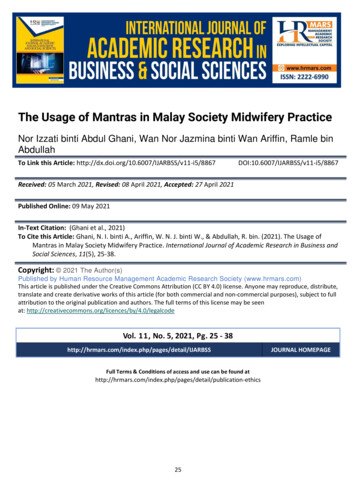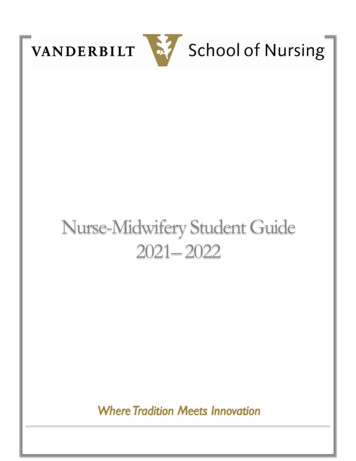
Transcription
Mathematics forNursing and MidwiferyThe module covers concepts such as: Maths refresher Fractions, Percentage and Ratios Decimals and rounding Unit conversions Rate1 P ag e
Mathematics forNursing andMidwiferyContentsIntroduction . 31.Arithmetic of whole numbers . 42.Naming fractions. 63.Equivalent fractions . 74.Working with decimals. 85.Rounding and estimating . 96.Converting decimals into fractions . 107.Converting fractions into decimals . 118.Fractions – addition, subtraction, multiplication and division . 129.Percentage . 1510. Ratios . 1711. Units and unit conversion. 2012. Rate . 2513. Nursing Examples . 27Answers . 302 P ag e
IntroductionClinical nursing practice requires accurate numerical calculation and problem solving skills.Mastery of these skills is essential to ensure patient safety.This workbook is designed to build student confidence and competence in foundationalmaths skills and their application to clinical calculations. You can work through modules atyour own pace, attempt the practice questions and check answers. Follow links to externalresources as needed.Use this workbook to strengthen your understanding and progression through theIntellilearn modules. Refer also to the clinical calculation numeracy resources in yoursubject site.3 P ag e
1. Arithmetic of whole numbersIntegersThe most commonly used numbers in arithmetic are integers, which are positive and negative whole numbersincluding zero. Positive integers are 1, 2, 3, 4, 5 and so on.The negative integers are -1, -2, -3, -4, -5 and so on. Decimal fractions are not integers because they are‘parts of a whole’, for instance, 0.6 is 6 tenths of a whole.Directed Numbers (negative and positive integers)Directed numbers are like arrows with a particular size and direction ( and ). They have a magnitude(size) and a direction (positive or negative). The positive ( ) and negative (-) symbols are used to signify theirdirection. Note that when using the calculator, we use the ( ) key rather than the subtraction key. Each negativenumber may also need to be surrounded by brackets (𝑒𝑒. 𝑔𝑔 ( 3) ( 3) 0) for your calculator to interpret itcorrectly.When naming directed numbers, we use the terms negative and positive numbers. The terms plus and minus areavoided unless you are indicating that an operation is taking place (addition and subtraction).( 3) ( 3) 0 is read as ‘negative 3 plus positive 3 equals zero’. Generally, the positive ( ) symbol isn’t shownwith positive numbers but can be assumed when a number has no sign (e.g 3 means 3).To use a graphic symbol we can display ( 5) and ( 5) as:This graphic symbol is known as a number line and can be used to show how and why operations work.Addition: To add a number we move to the right:2 4 6 20( 2) ( 6) -2-2 426 604In this example we added a positive number beginning at a negative number. Start at zero, move in a negativedirection two places, then move in a positive direction six places. The answer is four.Question 1a: Represent 2 3 04 P ag e
Subtraction: To subtract a positive number we move that number of places to the left.For example, 3 4 ( 1) Start at zero Move three spaces to the right (in a positive direction) Move four spaces to the left (in a negative direction) The answer is negative oneWe can think about this as if we were on a lift. If we start at the ground floor and go up three floors, then downfour floors, we would be one level below ground. Note: To subtract an integer means to add its’ opposite. To subtract a negative number we move to theright rather than the left – in a positive direction.For example: ( 2) ( 5) 3“negative 2 minus negative 5” meaning ( 2) 5 (adding the opposite)-2-2 503Question 1b: Your turn to represent ( 2) – ( 5) 0Two key points: Subtracting a negative number is the same as adding its opposite. 4 ( 3) 4 3 7Adding a negative number is the same as subtracting a positive number. 4 ( 2) 4 2 2Question 2: Your Turna. Find the sum of 3, 6 & 4b. Find the difference of 6 and 4c. Find the product of (multiply) 7 & 3d. Find the quotient of 20 and 4 (divide 20 by 4)e. Find the factors of 24 (factors are whole numbers that divide exactly into another number)f.Find the first five multiples of 7 (multiples are numbers that can be divided by another number –in this case 7 – without a remainder).Watch this short Khan Academy video for further explanation:“Learn how to add and subtract negative -examples5 P ag e
2. Naming fractions Fractions are representations of “parts of a whole”A key concept is that division and fractions are linked. Even the division symbol ( ) is a fraction.1𝑖𝑖𝑖𝑖 𝑡𝑡ℎ𝑒𝑒 𝑠𝑠𝑠𝑠𝑠𝑠𝑠𝑠 𝑎𝑎𝑎𝑎 1 ��𝑑 𝑏𝑏𝑏𝑏 2 𝑤𝑤ℎ𝑖𝑖𝑖𝑖ℎ 𝑖𝑖𝑖𝑖 0.5.23A fraction is made up of two main parts: 4 ��𝐷𝐷The denominator represents how many parts of the whole there are, and the numerator indicates how many ofthe parts are of interest.For instance,58of a pie means that we have cut a pie into 8 even pieces and we are only interested in the five thatare left on the plate. Fractions should always be displayed in their simplest form. For example,612Strategies for converting fractions into their simplest form will be covered over the next sections. 1is written as 2A proper fraction has a numerator smaller than the denominator, for example,34This representation shows that we have four equal parts and have shaded three of them,therefore 34An improper fraction has a numerator larger than the denominator, for example,43Here we have two ‘wholes’ divided into three equal parts.Three parts of ‘3 equal parts’ makes a ‘whole’ plus onemore part makes ‘one whole and one third’ or ‘four thirds’ Therefore, a mixed fraction has a whole number and a fraction,1for example, 1 3Question 3: Your Turn:Name the fractions:a) What fraction of the large square is black?b) What fraction of the large square has vertical lines?c) What fraction of the large square has diagonal lines?d) What fraction of the large square has wavy lines?Watch this short Khan Academy video for further explanation: “Introduction thmetic/fractions/understanding fractions/v/introduction-to-fractions6 P ag e
3. Equivalent fractionsEquivalence is a concept that is easy to understand when a fraction wall is used.As you can see, each row has been split into different fractions: top row into 2 halves, bottom row 12 twelfths. Anequivalent fraction splits the row at the same place. Therefore:1 2 3 456 2 4 6 8 10 12The more pieces I split the row into (denominator), the more pieces I will need (numerator).To create an equivalent fraction mathematically, whatever I do to the numerator (multiply or divide), I must also doto the denominator and vice versa, whatever I do to the denominator I must do to the numerator. Take23as anexample, if I multiply the numerator by 4, then I must multiply the denominator by 4 to create an equivalentfraction:2 48 3 412Example problems: Use what you have understood about equivalent fractions to find the missing values in thesefraction pairs.1.2.35 27 81Answer: The denominator was multiplied by 4. (20 5 4)20So the numerator must by multiplied by 4.9Answer: The numerator was divided by 3. (27 9 3)So the denominator must be divided by 3.Question 4: Your Turn:a)b)c)d)23579 945 3010524 13 3 45 427 3 81 312 209 27e) What fraction of thelarge square has dots?f) What fraction of thelarge square hashorizontal lines?Watch this short Khan Academy video for further explanation:“Equivalent metic/fractions/Equivalent fractions/v/equivalent-fractions7 P ag e
4. Working with decimalsKey Ideas:The decimal separates whole numbers from parts of a whole.For instance, 3.6; three is the whole number and 6 tenths of a whole.Each digit in a number has a ‘place value’ (related to one).The value depends on the position of the digit in that number.Each position can be thought of as columns.Each column is a power of ten.For example, let’s look at 56.39Tens1x10Ones1TenthsHundredths561031001195 101 506 1 613 10 (3 10 1 ) 0.319 100 (9 10 2 ) 0.09A recurring decimal is a decimal fraction where a digit repeats itself indefinitely.For example, two thirds 0.666666Because the number repeats itself from the tenths position a dot can be written above the 6 as such 0.6̇1If the number was one sixth( ), which as a decimal is 0.16666, then we signify as 0.16̇6If the number contained a cluster of repeating digits, for example, five elevenths 0.454545 we write 0.4̇ 5̇A terminating decimal is a number that terminates after a finite (not infinite) number of places, for example:254 10 or 0.4; andWorking with Decimals316 0.1875 (terminating after 5)What happens when we multiply or divide by ten, or powers of ten?Patterns are identified when multiplying by ten. Often it is said that when multiplying by ten we move the decimalone place to the right. This is actually something we do in practice but it is actually the digits that move.When we multiply by ten, all digits in the number become ten times larger and they move to the left.What happens when we divide by 10? All the digits move to the right.963.32 10 96.332 all of the digits more one place to the right.963.32 10 9633.2all of the digits move one place to the left.65.320Another key point when working with addition or subtraction of numbers is to line up thedecimal points. A zero can be regarded as a place holder. For example, 65.32 74.634 (see right)8 P ag e 74.634139.954
5. Rounding and estimatingRounding numbers is a method of summarising a number to make calculations easier to solve. Rounding decreasesthe accuracy of a number. Rounding to a specified integer or decimal is important when answers need to be givento a particular degree of accuracy.The Rules for Rounding:1.2.3.4.Choose the last digit to keep.If the digit to the right of the chosen digit is 5 or greater, increase the chosen digit by 1.If the digit to the right of the chosen digit is less than 5, the chosen digit stays the same.All digits to the right are now removed.For example, what is 7 divided by 9 rounded to 3 decimal places?So, 7 9 0.777777777777777777777777777777777777 The chosen digit is the third seven (3 decimal places).The digit to the right of the chosen digit is 7, which is larger than 5, so we increase the 7 by 1, therebychanging this digit to an 8. 7 9 0.778 to three decimal places.5. The quotient in rule 4 above is called a recurring decimal. This can also be represented as 0.7̇ . The dotabove the 7 signifies that the digit repeats. If the number was 0.161616, it would have two dots tosymbolise the two repeating digits: 0. 1̇ 6̇Estimating is a very important ability which is often ignored. A leading cause of getting math problems wrong isbecause of entering the numbers into the calculator incorrectly. It helps to be able to estimate the answer to checkif your calculations are correct.Some simple methods of estimation:o Rounding: 273.34 314.37 ? If we round to the tens we get 270 310 which is much easierand quicker. We now know that 273.34 314.37 should equal approximately 580.o Compatible Numbers: 527 12 ? If we increase 527 to 530 and decrease 12 to 10, we have530 10 5300. A much easier calculation.o Cluster Estimation: 357 342 370 327 ? All four numbers are clustered around 350, somelarger, some smaller. So we can estimate using 350 4 1400.Example Problems:1. Round the following to 2 decimal places:a. 22.6783 gives 22.68b. 34.6332 gives 34.63c. 29.9999 gives 30.002. Estimate the following:a. 22.5684 57.355 23 57 80b. 357 19 360 20 18c. 27 36 22 31 30 4 120Question 5: Your Turn:A. Round the following to 3 decimal places:a. 34.5994 b. 56.6734 9 P a geWatch this short Khan Academyvideos for further explanation:“Rounding decimals: to the nearest /v/rounding-decimalsB. Estimate the following:a. 34 x 62 b. 35.9987 – 12.76
6. Converting decimals into fractionsDecimals are an almost universal method of displaying data, particularly given that it is easier to enter decimals,1rather than fractions, into computers. But fractions can be more accurate. For example, is not 0.33 it is 0.33̇3The method used to convert decimals into fractions is based on the notion of place value. The place value of thelast digit in the decimal determines the denominator: tenths, hundredths, thousandths, and so on Example problems:511. 0.5 has 5 in the tenths column. Therefore, 0.5 is 10 2 (simplified to an equivalent fraction).37532. 0.375 has the 5 in the thousandth column. Therefore, 0.375 is 1000 82513. 1.25 has 5 in the hundredths column and you have 1 100 1 4The hardest part is converting to the lowest equivalent fraction. If you have a scientific calculator, you can use thefraction button. This button looks different on different calculators so read your manual if unsure.375If we take 1000 from example 2 above:Enter 375 then3followed by 1000 press and answer shows as 8.NOTE: The calculator does not work for rounded decimals; especially thirds. For example, 0.333 The table below lists some commonly encountered fractions expressed in their decimal ecimal0.50.66667.750.2Question 6: Your Turn:(No Calculator first, then check.)a)0.65 b)2.666 c)0.54 d)3.14 e) What is 40 multiplied by 0.2 (use your knowledge of fractions to solve)10 P a g eFraction1223341513
7. Converting fractions into decimalsConverting fractions into decimals is based on place value. For example, applying what you have understood about2equivalent fractions, we can easily convert 5 into a decimal. First we need to convert to a denominator that has a 1022 2base. Let’s convert into tenths 55 2 410 we can say that two fifths is the same as four tenths: 0.4Converting a fraction to decimal form is a simple procedure because we simply use the divide key on the calculator.Note: If you have a mixed number, convert it to an improper fraction before dividing it on your calculator.Example problems:1.2.3.233 2 3 0.66666666666 0.67 3 8 0.3758173 17 3 5.6666666 5.6754. 3 9 (27 5) 9 3.555555556 3.565.Question 7. Your Turn: (Round your answer to three decimal places where appropriate)a)b)1723572 2c) 56 3 d)295 Watch this short Khan Academy video for further explanation:“Converting fractions to decimals” (and vice nverting-fractions-to-decimals11 Page
8. Fractions – addition, subtraction,multiplication and divisionAdding and subtracting fractions draws on the concept of equivalent fractions. The golden rule is that youcan only add and subtract fractions if they have the same denominator, for example,1312 3 3.However, if two fractions do not have the same denominator, we must use equivalent fractions to find a “commondenominator” before they can be added together.For instance, we cannot simply addarriving at an answer of26141 2 because these fractions have different denominators (4 and 2). As such,(two sixths) would be incorrect. Before these fractions can be added together, they mustboth have the same denominator.From the image at right, we can see that we have three quarters of a whole cake. So to work this abstractly, we needto decide on a common denominator, 4, which is the lowest commondenominator. Now use the equivalent fractions concept to change122multiplying both the numerator and denominator by two: 2 x 2 412𝑖𝑖𝑖𝑖𝑖𝑖𝑖𝑖24byNow that the denominators are the same, the addition can be carried out:1 2 3 4 4 4Let’s try another:131 2 We cannot simply add these fractions; again we need to find the lowest common denominator. The easiestway to do this is to multiply the denominators:13𝑎𝑎𝑎𝑎𝑎𝑎12(2 x 3 6). Therefore, both fractions can have adenominator of 6, yet we need to change the numerator. The next step is to convert both fractions into sixths as an121221equivalent form. How many sixths is one third? 3 6 3 2 6 And how many sixths is one half? 2 36133 236Therefore:131235 2 6 6 6With practise, a pattern forms, as is illustrated in the next example:1 21 5 2 35 6 11 3 53 5 5 31515In the example above, the lowest common denominator is found by multiplying 3 and 5, and then the numeratorsare multiplied by 5 and 3 respectively.Question 8. Try the following problems to practice adding fractions:a)1b)3342 5 2 7 12 Page
Subtraction is a similar procedure:(2 4) (1 3)2 1 (3 4)3 483 12 12 512Question 9. Try the following problems to practice adding fractions:9 1 12 31 1 f)3 2e)Watch this short Khan Academy video for further explanation: “Adding and v/adding-and-subtracting-fractionsCompared to addition and subtraction, multiplication anddivision of fractions is easy, but sometimes a1challenge to understand how and why the procedure works mathematically. For example, imagine I have of a pie2and I want to share it between 2 people. Each person gets a quarter of the pie.1Mathematically, this example would be written as:211 2 4.Remember that fractions and division are related; in this way, multiplying by a half is the same as dividing by two.111So 2 (two people to share) of 2 (the amount of pie) is 4 (the amount each person will get).27But what if the question was more challenging: 3 16 ? This problem is not as easy as splitting pies.A mathematical strategy to use is: “Multiply the numerators then multiply the denominators”Therefore,237(2 7)147 16 (3 16) 48 24An alternative method you may recall from school is to simplify each term first. Remember, ‘What we do to one side,we must do to the other.’27The first thing we do is look to see if there are any common multiples. For 3 16 ? we can see that 2 is a multipleof 16, which means that we can divide top and bottom by 2:2 23 716 217 381 73 8 724Division of fractions seems odd, but it is a simple concept:You may recall the expression ‘invert and multiply’, which means we flip the divisor fraction (second term fraction).12Hence, 2 𝑖𝑖𝑖𝑖 𝑡𝑡ℎ𝑒𝑒 𝑠𝑠𝑠𝑠𝑠𝑠𝑠𝑠 𝑎𝑎𝑎𝑎 1This ‘flipped’ fraction is referred to as the reciprocal of the original fraction.21Therefore, 3 2 is the same as13 Page232 1 (2 2)(3 1)41 3 1 3 Note: dividing by half doubled the answer.
Question 10. Use fractions to complete the following:21. Find the reciprocal of 2 5123. 1 6 9 285. 2 3 57. 729 492.2 13 4.36. 5 ( 25) ( 5)37724 2 7 8. If we multiply 8 and the reciprocal or 2,what do we get? 9. Which is the better score in a physiology test; 17 out of 20 or 22 out of 25?10. What fraction of H2O2 is hydrogen?111. A patient uses a glass that holds 5 of a jug’s volume. The patient drinks eight full glasses during the course ofthe day. What fraction of the second jug is left at the end of the day?14 Page
9. PercentageThe concept of percentage is an extension of the material we have already covered about fractions. To allowcomparisons between fractions we need to use the same denominator. As such, all percentages use 100 as thedenominator. The word percent or “per cent” means per 100. Therefore, 27% is27100.To use percentage in a calculation, the simple mathematical procedure is modelled below:25For example, 25% of 40 is 100 40 10Percentages are most commonly used to compare parts of an original. For instance, the phrase ‘30% off sale,’indicates that whatever the original price, the new price is 30% less. However, the question might be more complex,such as, “How much is left?” or “How much was the original?”Example problems:a.An advertisement at the chicken shop states that on Tuesday everything is 22% off. If chicken breasts arenormally 9.99 per kilo. What is the new per kilo price?Step 1: SIMPLE PERCENTAGE:22100 9.99 2.20Step 2: DIFFERENCE: Since the price is cheaper by 22%, 2.20 is subtracted from the original: 9.99 – 2.20 7.79b.A new dress is now 237 reduced from 410. What is the percentage difference? As you can see, the problemis in reverse, so we approach it in reverse.Step 1: DIFFERENCE: Since it is a discount the difference between the two is the discount. Thus we need to subtract 237.00 from 410 to see what the discount was that we received. 410 – 237 173Step 2: SIMPLE PERCENTAGE: now we need to calculate what percentage of 410 was 173, and so we can use this𝑥𝑥equation: 100 410 173𝑥𝑥We can rearrange the problem in steps: 100 410 410 173 410 this step involved dividing 410 from𝑥𝑥173both sides to get 100 410173Now we have 𝑥𝑥 410 1001Next we work to get the 𝑥𝑥 on its own, so we multiply both sides by 100.Next we solve, so 0.42 multiplied by 100, 0.42 100 and we get 42. The percentage difference was 42%.Let’s check: 42% of 410 is 173, 410 - 173 237, the cost of the dress was 237.00 .Question 11. Use percentages to calculate the following:a) GST adds 10% to the price of most things. How much does a can of soft drink cost if it is 80c before GST?15 Page
b) When John is exercising his heart rate rises to 180 bpm. His resting heart rate is 70 % of this. Whatis his resting heart rate?c) Which of the following is the largest?16 Page35𝑜𝑜𝑜𝑜1625𝑜𝑜𝑜𝑜 0.065 𝑜𝑜𝑜𝑜 63%? (Convert to percentages)
10. RatiosA ratio is a comparison of the size of one number to the size of another number. A ratio representsfor every determined amount of one thing, how much there is of another thing. Ratios are usefulbecause they are unit-less. That is, the relationship between two numbers remains the sameregardless of the units in which they are measured.Ratios use the symbol : to separate quantities being compared. For example, 1:3 means 1 unit to 3 units.There is 1 red square to 3 blue squares1:31 to 31Ratios can be expressed as fractions but you can see from the above diagram that 1:3 is not the same as 3 . The1fraction equivalent is 4Example:A pancake recipe requires flour and milk to be mixed to a ratio of 1:3. This means one part flour to 3 parts milk. Nomatter what device is used to measure, the ratio must stay the same.So if I add 200 mL of flour, I add 200 mL x 3 600 mL of milkIf I add 1 cup of flour, I add 3 cups of milkIf I add 50 grams of flour, I add 150 grams of milkScaling ratiosA ratio can be scaled up:1:4 2:8Or scaled down:3:15 1:51:5 is the same as2:10 is the same as3:15 is the same as4:20 and so onScaling ratios is useful in the same way that simplifying fractions can be helpful, for example, in comparing values.For ratios the same process as simplifying fractions is applied – that is, scaling must be applied to both numbers.17 Page
For example, a first year physiology subject has 36 males and 48 females, whereas the clinical practice subject has 64males and 80 females. You are asked to work out which cohort has the largest male to female ratio.The male: female ratios can be expressed as:36:48 – physiology subject64:80 – clinical practice subjectBoth numbers of the ratio 36:48 can be divided by 12 to leave the ratio 3:4Both numbers of the ratio 64:80 can be divided by 16 to leave the ratio 4:5These two ratios cannot be easily directly compared, but they can be rescaled to a common value of 20 for thefemales, against which the males can be compared if they are rescaled equivalently.3 (x5):4 (x5) 15:20 – physiology subject4 (x4):5 (x4) 16:20 – clinical practice subjectComparing the ratios now shows that the clinical practice subject has a slightly higher ratio of males to females.Question 12. Use ratios to complete the following:a) For a 1:5 concentration of cordial drink, how much cordial concentrate do I have to add to water to make upa 600 mL jug?b) Jane reads 25 pages in 30 minutes. How long does it take her to read 200 pages?c) A pulse is measured as 17 beats over 15 seconds. What is the heart rate per minute?d) Which of the following ratios is the odd one out? 9:27, 3:9, 8:28, 25:7518 Page
Ratios as percentagesRecall from the figures above, that the numbers in the ratio represents parts of a whole. To convert a ratio topercentage values, simply add the two parts of the ratio, to give the whole (total) and for each part, divide by thetotal. Then use the normal procedure to calculate the percentage by multiplying by 100.Using the example from above, the table below calculates the percentage values of males and females for eachsubject from the ratios. Percentages allow for a quantified comparison.Physiology 3:4TotalMaleFemaleClinical practice 4:573 100 42.9%74 100 57.1%794 100 44.4%95 100 55.6%9We are correct; there are more males than females (in percent) in the clinical practice subject.Dilutions using the expression solute in diluentSometimes drug ratios are written in the form of solute (usually drug to be given) in diluent (e.g. water or salinesolution); for example 1 in 4.This means 1 part of every 4 of the final volume is solute and this is mixed with 3 parts of the diluent. When1expressed in this way the total parts is 4. This relationship can be expressed as the fraction 4diluentSolute (drug to be given)Question 13:a) Write 2:3 in the form “2 in ?”b) Write a solution of 1 in 8 in the form of a ratio.c) How much concentrate do you need to make the following dilutions?a) 500 mL of a 1 in 4 solutionb) 600 mL of a 1:5 solutiond) Heparin, an anticoagulant, is available in a strength of 5000 units/mL. If 3000 units is required, what volumeof heparin will be injected?19 Page
11. Units and unit conversionMeasurement is used every day to describe quantity. There are various types of measurements such as time,distance, speed, weight and so on. There are also various systems of units of measure, for example, the Metricsystem and the Imperial system. Within each system, for each base unit, other units are defined to reflect divisionsor multiples of the base unit. This is helpful for us to have a range of unit terms that reflect different scaleMeasurements consist of two parts – the number and the identifying unit.In scientific measurements, units derived from the metric system are the preferred units. The metric system is adecimal system in which larger and smaller units are related by factors of 10.Table 1: Common Prefixes of the Metric SystemPrefixmega-AbbreviationMRelationship to Unit1 000 000 x Unitkilo-k1000 x Unitdeci-dcenti-cmilli-mmicro-µnano-nBase unit1/10 x Unitor0.1 x Unit1/100 x Unitor0.01 x Unit1/1000 x Unitor0.001 x Unit1/1 000 000 x Unitor0.000001 x Unit1/1 000 000 000 x Unit or0.000000001 x UnitExample2.4ML -Olympic sized swimmingpoolThe average newborn baby weighs3.5kgmetre, gram, litre,2dm - roughly the length of apencilA fingernail is about 1cm wideA paperclip is about 1mm thickhuman hair can be up to 181 µmDNA is 5nm wideTable 2: Common Metric ConversionsUnitLarger UnitSmaller Unit1 metre1 kilometre 1000 metres100 centimetres 1 metre1000 millimetres 1 metre1 gram1 kilogram 1000 grams1000 milligrams 1 gram1 000 000 micrograms 1 gram1 litre1 kilolitre 1000 litres1000 millilitres 1 litreOften we are required to convert a unit of measure; we may be travelling and need to convert measurements fromimperial to metric (e.g. mile to kilometres), or we may need to convert units of different scale (e.g. millimetres tometres) for ease of comparison. In the fields of science and medicine, converting measurement can be a dailyactivity.20 Page
Easy conversion method for metric conversions To convert from large units to smaller units MULITPLY by 1000kggx1000x1000mgmicrogx1000To convert from small units to larger units DIVIDE by 1000microg 1000mgg 1000kg 1000In more complex conversions it helps to apply a formula to convert units of measure. However, it isessential to understand the how and why of the formula, otherwise the activity becomes one we commit to memorywithout understanding what is
1 Page Mathematics for Nursing and Midwifery . The module covers concepts such as: Maths refresher Fractions, Percentage and Ratios Decimals and rounding Unit conversions Rate










